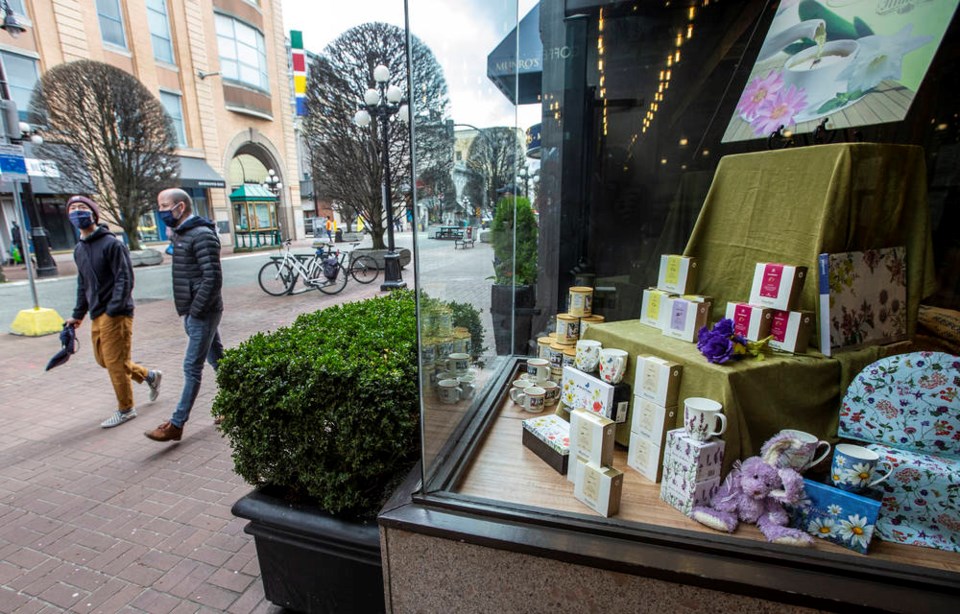Politicians spent several hours this week in the legislature debating B.C.’s first attempt to restart the economy, just as the second one is ready for lift-off.
Jobs Minister Ravi Kahlon acknowledged times are tough but insisted 99 per cent of the jobs are back and the government support efforts are working.
Then Liberal critic Todd Stone walked out the door and up Government Street. He came back with a different view.
“It’s just staggering, in early to mid-June, that if you’re lucky, you might walk past one other human being in an entire block of downtown Victoria.”
After an hour walking around downtown, he told the legislature he saw “business after business after business” closed or reducing their hours.
One restaurant’s sign said it was only open two days a week. So was a clothing store. A sports retailer was managing four days a week.
“The profile of our downtowns and communities across the province is very different today, from a small-business perspective, than it was one year ago,” said Stone.
Kahlon, a Richmond MLA who was born and raised in Victoria, agreed that downtown is quiet because of remote work and the lack of tourists.
“There are some unknowns around what that will mean going forward and whether there will be some sort of return to work … It’s a challenging time.”
The pandemic focus is shifting from the medical side to the economic story and there is lots to argue about when it comes to how the government is handling it.
The COVID-19 tracking continues to look encouraging.
When plans for “Restart 2.0” were announced on May 25, three criteria were set before B.C. would move on June 15 to a less-restrictive stage.
They’ve already been met, by and large. Case counts and hospitalizations are declining, as was required.
The government wanted a minimum 65 per cent of the adult population vaccinated with at least one dose before moving to phase two. It’s now more than 74 per cent.
So barring an abrupt change in the trend lines, B.C. will move to the second phase of the restart on June 15.
That means recreational travel within B.C., indoor gatherings of up to 50 people, and several other adjustments to current limits (including playdates).
One of the unknowns revolves around how many workers will fill jobs once they resume.
Stone said a new theme is emerging of a labour shortage. Businesses are starting to worry — not about restrictive health measures, but “because they can’t get the employees that they need in order to open up their establishments …”
Kahlon said that may be a problem in the restaurant industry, but it’s not across all sectors. He noted another potential issue with the restart is fear amongst workers.
“There’s a sense from those that have been away from work … a bit of fear to get back and be in places where there’s a lot of people.”
He expects that will fade as more people enter the workforce.
The NDP has focused on the statistic showing B.C. employment is now 99 per cent of pre-pandemic levels.
Kahlon said it is quite extraordinary and shows the resilience of the B.C. economy.
But Liberals query the shape of that return.
Stone said it’s based on a massive increase in the public sector and a hike in part-time work.
Private-sector jobs have dropped significantly, he said.
Politicians unanimously approved hundreds of millions of dollars for business relief in March 2020, but there was a long lag in the programs and the details only emerged four days before the September election call.
Stone said there are lags in the grants being disbursed as well, but Kahlon said there were problems with documentation.
The small business grant program that was launched last October had to be expanded in December and again in March. There have been 17,895 applications, 10,217 of them approved for a total of $214 million, he said.
Kahlon said 40 per cent of them came in with inaccurate banking information, “which obviously slows the process down.” The same problem developed with the circuit-breaker grants.
Those funds are over-subscribed, so the next debate will be whether to commit more money, or count on businesses to bounce back on their own.
lleyne@timescolonist.com



